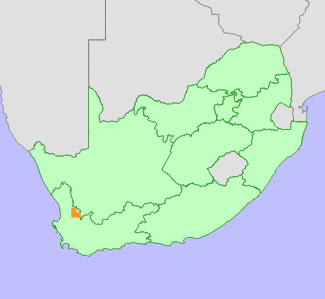|
Scientific Name | Polycarena exigua Hilliard |
Higher Classification | Dicotyledons |
Family | SCROPHULARIACEAE |
National Status |
Status and Criteria | Rare |
Assessment Date | 2018/11/14 |
Assessor(s) | L. von Staden |
Justification | A range-restricted (EOO 164 km²) but locally abundant habitat specialist endemic to the Cederberg. The entire distribution range of this species falls within a protected wilderness area. It is therefore listed under the IUCN 3.1 Criteria, globally, as Least Concern but is nationally categorised as Rare. |
Distribution |
Endemism | South African endemic |
Provincial distribution | Western Cape |
Range | This species is a Cederberg endemic. |
Habitat and Ecology |
Major system | Terrestrial |
Major habitats | Cederberg Sandstone Fynbos |
Description | Plants grow in sandstone fynbos in damp places, depressions in rock sheets, or under overhanging rocks. |
Threats |
| It is entirely confined to a protected wilderness area and is not threatened. |
Population |
It is a locally abundant annual herb.
|
Population trend | Stable |
Conservation |
| This species is conserved in the Cederberg Wilderness Area. |
Assessment History |
Taxon assessed |
Status and Criteria |
Citation/Red List version | | Polycarena exigua Hilliard | Least Concern | Raimondo et al. (2009) | |
Bibliography |
Goldblatt, P. and Manning, J.C. 2000. Cape Plants: A conspectus of the Cape Flora of South Africa. Strelitzia 9. National Botanical Institute, Cape Town.
Hilliard, O.M. 1994. The Manuleae: a tribe of Scrophulariaceae. Edinburgh University Press, Edinburgh.
Raimondo, D., von Staden, L., Foden, W., Victor, J.E., Helme, N.A., Turner, R.C., Kamundi, D.A. and Manyama, P.A. 2009. Red List of South African Plants. Strelitzia 25. South African National Biodiversity Institute, Pretoria.
|
Citation |
| von Staden, L. 2018. Polycarena exigua Hilliard. National Assessment: Red List of South African Plants version 2024.1. Accessed on 2025/12/03 |
 Comment on this assessment
Comment on this assessment


